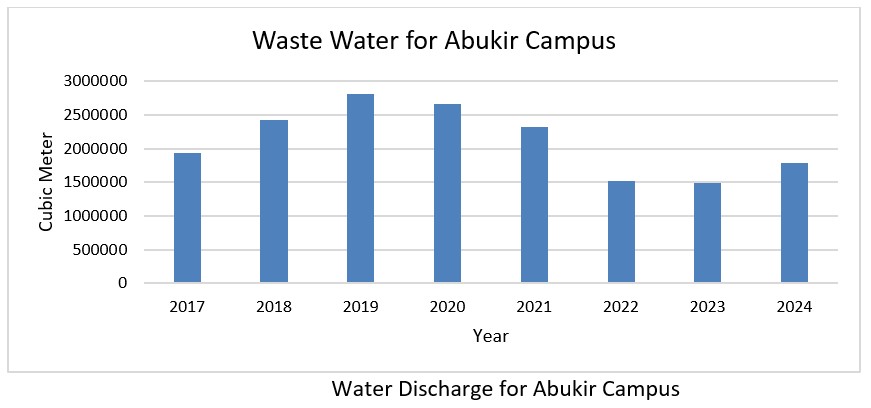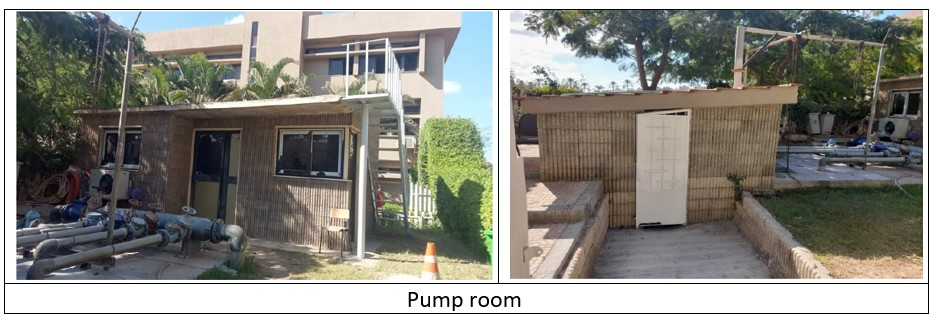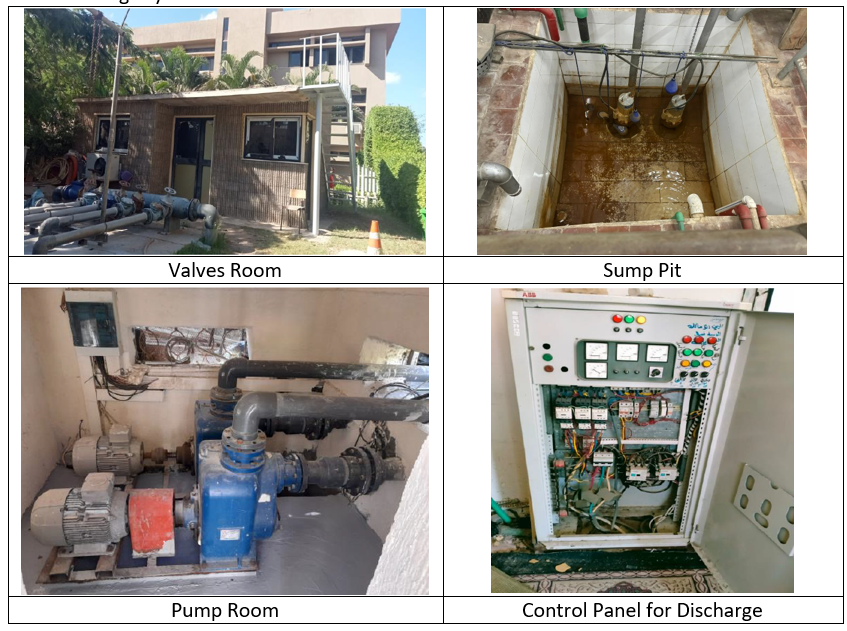
AASTMT applies an integrated wastewater management system to ensure safe treatment, reuse, and environmental protection. All domestic sewage is connected to public treatment networks operated by government facilities in compliance with Law No. 93 (1962) and Decree No. 44 (2000). At the Alamein Campus, a medical wastewater treatment unit removes biological and chemical contaminants through sedimentation, biological treatment, UV sterilization, and reverse osmosis, enabling reuse for irrigation and cleaning. At the Abu Qir Campus, a central wastewater station collects sewage from campus buildings. It includes a 12 m³ sump pit, submersible and self-priming pumps, and flow meters for continuous monitoring and controlled discharge into the public sewer. AASTMT’s network separates sewage and stormwater lines, prevents contamination, and supports reuse of treated water in irrigation, aligning with SDG 6. The Environmental Monitoring & Climate Change Laboratory regularly tests water quality to ensure system efficiency and compliance with environmental standards.
AASTMT – Alamein Campus has established a specialized wastewater treatment system serving its medical and laboratory facilities, ensuring that all discharged water is safely treated and reused while preventing pollution of natural water bodies. This advanced medical wastewater treatment unit is designed to remove biological, chemical, and physical contaminants, providing safe effluent that complies with environmental health standards. The system plays a vital role in protecting both human health and the surrounding ecosystem by minimizing the risks associated with untreated medical effluents.
System Components and Process:
Wastewater Treatment for Alamain Campus Hospital on AASTMT webpage

AASTMT reinforces its wastewater management system through a comprehensive network of water supply, drainage, and irrigation infrastructure, all of which contribute to the overall wastewater treatment and reuse cycle in support of SDG 6. The following layouts from the AASTMT demonstrate how the campuses are designed to support safe wastewater handling, pollution prevention, and resource recovery:
Discharge water is monitored and recorded via metering system in all AASTMT campuses with discharge yearly values presented for Abukir campus.


↵
The AASTMT wastewater treatment process involves directing all wastewater into the sewer system, where it undergoes further treatment at government-designed public sewage facilities. This process ensures that the treated water meets all discharge standards for watercourses, specifically in compliance with the Egyptian Standard of Ministry of Housing, Utilities, and Urban Communities, No. 44 of the Year 2000, Amending the Executive Regulations for Law No. 93 of the Year 1962 Concerning the Disposal of Wastewater. The standard specifies general design data for wastewater treatment plants. Following these regulations is mandatory for any construction projects in Egypt to comply with these environmental standards, to ensure proper wastewater disposal systems. Link for regulation can be found below.
Before discharging onto the public sewage systems, wastewater is collected in a collection station at the main entrance of the AAST Abu Kir campus which is equipped with a sump to collect wastewater from the surrounding area. This area includes buildings for the College of Engineering, College of Computing, student housing, hotels, administration buildings, and the main cafeteria. The wastewater drainage network extends between these buildings and leads to a sump with a storage capacity of approximately 12 cubic meters. The sump dimensions are about 2x2 inches in diameter and can hold around 12 cubic meters. The wastewater discharge system is equipped with flowmeters for monitoring and recording wastewater discharge monthly. Components of the wastewater station include:

An example, the Western Treatment Plant in the city of Sixth of October is one of the sewage treatment stations serving the campus of Smart Village in Cairo.



In addition, it has its own Environmental Monitoring & Climate Change Laboratory to promote and improve research activities in AASTMT and help conduct consultancies as part of extension services to the industries. The lab specializes in carrying out the following activities and studies:
The laboritories play a pivotal role in enhancing AASTMT's wastewater management practices. By conducting regular water quality testing, this ensures compliance with environmental standards and minimizes risks of pollution or contamination. The lab also analyzes wastewater for potential contaminants, assess the efficiency of the wastewater treatment processes. Additionally, it supports research on advanced wastewater treatment technologies which further strengthens AASTMT's commitment to sustainable water management.
Link of Evidence:
Environmental Monitoring & Climate Change Lab on AASTMT webpage
Wastewater Treatment on AASTMT webpage [2]